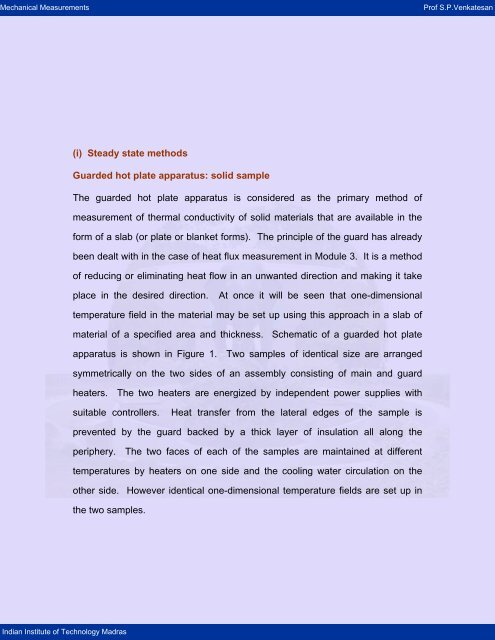1. Thermo-physical properties 2. Radiation properties - nptel - Indian ...
1. Thermo-physical properties 2. Radiation properties - nptel - Indian ...
1. Thermo-physical properties 2. Radiation properties - nptel - Indian ...
You also want an ePaper? Increase the reach of your titles
YUMPU automatically turns print PDFs into web optimized ePapers that Google loves.
Mechanical Measurements Prof S.P.Venkatesan<br />
<strong>Indian</strong> Institute of Technology Madras<br />
(i) Steady state methods<br />
Guarded hot plate apparatus: solid sample<br />
The guarded hot plate apparatus is considered as the primary method of<br />
measurement of thermal conductivity of solid materials that are available in the<br />
form of a slab (or plate or blanket forms). The principle of the guard has already<br />
been dealt with in the case of heat flux measurement in Module 3. It is a method<br />
of reducing or eliminating heat flow in an unwanted direction and making it take<br />
place in the desired direction. At once it will be seen that one-dimensional<br />
temperature field in the material may be set up using this approach in a slab of<br />
material of a specified area and thickness. Schematic of a guarded hot plate<br />
apparatus is shown in Figure <strong>1.</strong> Two samples of identical size are arranged<br />
symmetrically on the two sides of an assembly consisting of main and guard<br />
heaters. The two heaters are energized by independent power supplies with<br />
suitable controllers. Heat transfer from the lateral edges of the sample is<br />
prevented by the guard backed by a thick layer of insulation all along the<br />
periphery. The two faces of each of the samples are maintained at different<br />
temperatures by heaters on one side and the cooling water circulation on the<br />
other side. However identical one-dimensional temperature fields are set up in<br />
the two samples.
















